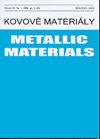冷丝GTAW与热丝GTAW沉积ERNiCrFe-7A金属的显微组织比较
IF 0.7
4区 材料科学
Q4 MATERIALS SCIENCE, MULTIDISCIPLINARY
引用次数: 0
摘要
ERNiCrFe-7A钎料广泛用于焊接铬镍铁合金,常被考虑用于制造核岛主设备的反应堆压力容器、蒸汽发生器等关键部件。本文采用冷丝法和热丝法分别制备了ERNiCrFe-7A沉积金属。采用OM、XRD、SEM、TEM等方法研究了沉积金属的微观结构和析出机理。结果表明:冷丝和热丝GTAW均可获得较好的ERNiCrFe-7A镀层质量。沉积金属基体为γ -奥氏体。沉积金属的微观结构具有细胞状枝晶特征。晶内析出相为MX相(M = Nb和Ti, X = C和/或N),晶间析出相为富cr的m23c6相。冷丝GTAW的热输入量高于热丝GTAW,冷丝GTAW的柱状晶粒比热丝GTAW宽,冷丝GTAW的MX相和m23c6相数量多于热丝GTAW。本文章由计算机程序翻译,如有差异,请以英文原文为准。
Comparison of the microstructure of ERNiCrFe-7A deposited metal by cold wire GTAW and hot wire GTAW
ERNiCrFe-7A filler metal is widely used for welding Inconel 690 alloy, which is often considered for fabricating key components such as reactor pressure vessel and steam generator of nuclear island main equipment. In this work, ERNiCrFe-7A deposited metal was prepared by cold wire and hot wire GTAW process separately. The microstructure and mechanism of precipitation of deposited metal were studied by OM, XRD, SEM, and TEM. Results show that both cold wire and hot wire GTAW can get good quality of ERNiCrFe-7A deposited metal. The matrix of deposited metal is γ -austenite. The microstructure of deposited metal has a cellular dendritic characteristic. The intragranular precipitates are MX phases (M = Nb and Ti, X = C and/or N), and the intergranular precipitates are Cr-rich M 23 C 6 phases. The heat input of cold wire GTAW is higher than that of hot wire GTAW, the columnar grains by cold wire GTAW are wider than those of hot wire GTAW, and the number of MX and M 23 C 6 phases by cold wire GTAW is more than that by hot wire GTAW.
求助全文
通过发布文献求助,成功后即可免费获取论文全文。
去求助
来源期刊

Kovove Materialy-Metallic Materials
MATERIALS SCIENCE, MULTIDISCIPLINARY-METALLURGY & METALLURGICAL ENGINEERING
CiteScore
1.20
自引率
14.30%
发文量
36
审稿时长
3 months
期刊介绍:
Kovove Materialy - Metallic Materials is dedicated to publishing original theoretical and experimental papers concerned with structural, nanostructured, and functional metallic and selected non-metallic materials. Emphasis is placed on those aspects of the science of materials that address:
the relationship between the microstructure of materials and their properties, including mechanical, electrical, magnetic and chemical properties;
the relationship between the microstructure of materials and the thermodynamics, kinetics and mechanisms of processes;
the synthesis and processing of materials, with emphasis on microstructural mechanisms and control;
advances in the characterization of the microstructure and properties of materials with experiments and models which help in understanding the properties of materials.
 求助内容:
求助内容: 应助结果提醒方式:
应助结果提醒方式:


